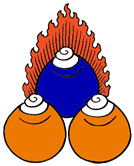| |

Studies
in
Buddhadharma
On Rebirth : Binding Intervals
 Contents
Contents  SiteMap
SiteMap

"There is a level of existence,
experienced in between death and birth."
Vasubandhu : Treasury of Abhidharma.
"Then, when the respiration has ceased, and the two carotid arteries
have been firmly pressed, remind the dying person with the following
words, if the individual was a spiritual teacher or a spiritual friend
greater than one self : 'Venerable One ! The inner radiance of the
ground is now arisen before You. Recognize it, and concentrate directly on
its experiential cultivation.'"
Padmasambhava :
The Great Liberation by Hearing, part one.
"There definitely is life after death."
XIVth Dalai Lama : Commentary on the Thirty Seven
Practices of a Bodhisattva.
|
In Indian religion and philosophy, rebirth ("puranrâjâti") is invoked to
explain why the ultimate state of consciousness is not attained in a
single lifetime, but the result of a long chain of experiences over
countless lifetimes in various sentient forms.
From one perspective, a person who remembers a past life may think of it
as representing a continuity of existence between lifespans, i.e. the
same person (with a certain name and body) is now a different
person (with another name and body). This view implies an enduring,
underlying, self-existing entity ("âtman") separate from the dissolving
aggregates of body & mind. It overlooks the characterization of the
process of becoming as one of constant change, both within and
between lives. Indeed, the newly-arising life is conditioned by but in no
respect identical to the preceding life ...
The Buddhadharma identified the many fallacies to which such a view leads.
The lack of such fixed self does not mean lack of continuity. For
example, a flame is transferred from one candle to another, or a fire
spreads from one field to another. In the same way as the new fire depends
on the original fire, there is a conditioned relationship between one
life and the next.
Rebirth is clearly one of the most controversial tenets in the
Buddhadharma. This is especially so in the context of Western materialism,
cherishing annihilation of body & mind after physical death. It is often
misunderstood, usually because one keeps a certain element within the
adopted (essentialist) philosophy of mind fixed (an "atman", a soul, a
higher self or whatever). The crucial point to understand here is the
absence of a named and naming reincarnating self, own-form or substantial
ego. The Buddhadharma is not essentialist, but process-based. The presence
of a functional ego is accepted, but this coarse mind also dies (perhaps
not simultaneous with the body). The subtle mind on which this coarse mind
is build eventually also ends. The only thing remaining is the specific
differential features of the very subtle mind of Clear Light. Insofar as
these features are the result of actions done by previous subtle & coarse
minds, they obscure this Clear Light stuffed with imprints
("âlaya-vijñâna") and trigger a new process of rebirth. Insofar as these
features are not the result of previous imprints, but reflect the specific
holomovement of each and every Clear Light mind ("âlaya-prajñâ" or
"âlaya-jñâna"), they do not automatically trigger such a process. However,
a mind free from obscurations can decide to trigger the process anyway.
This is not "rebirth" but merely an "emanation" (of form bodies) from that
specific awakened mind-stream.
|
Already in the early Buddhist texts, there is no
permanent consciousness moving from life to life. They refer to a level of
mind called the "luminous mind", seen as the most subtle or basic mode of
mind in terms of which the evolution of sentient beings through the round
of rebirths is conceived.
Becoming ("bhava") is the tenth link in the
samsaric chain of
dependent, conditioned arising ("pratîtya-samutpâda"). It refers to a
process of becoming conditioned by identification with the aggregates
of individuality : form, feeling, thought, volition & consciousness
(cf. "skandhas").
In the Buddhadharma, the conventional consciousness of a person, upon the
dissolution of the aggregate of the physical body (form), becomes one of
the contributing causes for the arising of a new group of heaps which may
again be considered an individual. As this rebirth or re-becoming does not
necessarily yield a human individual, becoming a human being is considered
to be very precious. Indeed, one may be reborn as a hell being, a ghost,
an animal, a demi-god or a god, and in all these cases one's chances for
enlightenment are slim.
This new consciousness is neither identical to, nor different or
completely distinct from, the old consciousness, but is a part of the
causal continuum at hand, reflecting moments of this specific
mind-stream. It is not the same,
because the mortal gross (coarse) & subtle minds of the previous person
completely dissolve. It is not different, because the immortal very
subtle mind of Clear Light or luminous mind is always the same in all
rebirths of the same consciousness-continuum, and this from beginningless
time all the way up to
Buddhahood. If
obscured by adventitious material stemming from the unwholesome activities
of body, speech & mind done in previous (coarse & subtle) becomings of the
same stream of consciousness, it will inevitably cause a new becoming.
The basic cause for this persistent re-arising of personality is the
abiding of ignorance ("avidyâ") in consciousness, in other
words, the presence of adventitious stuff obscuring the Clear Mind. When the latter is
uprooted by realizing the
wisdom-mind
apprehending
emptiness, rebirth ceases. However, Buddhas & Superior Bodhisattvas,
although no longer in need of a human rebirth, may choose to be reborn to
help sentient beings.
In the Abhidharma of the
Hînayâna and
Early Mâhayâna, a state
connecting the death of an individual and his following rebirth is
indicated. In the Yogâcârin School, "the practice of yoga school" or "Mind
Only School" and in
Dzogchen, the stream of consciousness is analyzed as a continuum of
moments of consciousness. The "gap" present between two of these
moments brings about, when meditated upon, an awareness of the very subtle
& luminous nature of consciousness itself, of the potential of its
primordial sentience. Each moment "dies" to re-become the "next" moment.
The "interval" between them is their "bardo". Hence, to yogic
sensibilities, bardo-experiences are ongoing. Of course, in practical
terms, all depends on what set of moments one designates.
Also in Tibetan Buddhism, the yogic & scholastic repository of the
complete Buddhadharma, so-called "in-between states" (Tib. "bardo"), have
been extensively studied, reflected upon & taken as objects of meditation.
Indeed, physical death and the intermediate state before rebirth are
deemed mere "intervals" in-between two moments.
In Padmasambhava's Bardo Thödol ("Liberation Through Hearing in the
Bardo"), six bardo-categories are differentiated. These categories
envisage the comprehensive dynamism of a particular, conventional
stream-of-consciousness, including its impermanence hand in hand with its
continuous features-in-process (permanent dynamics) :
1. the bardo of birth (or life) : between the
moment consciousness enters the new womb until the moment the first sign
of death appears ;
2. the bardo of dream : between the moment
one falls asleep until the moment of awakening ;
3. the bardo of meditation : between the
moment of going for refuge until the moment of dedication ;
4. the bardo of death : between the moment
the first sign of death appears until the moment the heart drop splits ;
5. the bardo of the intermediate state : between the moment the
luminosity of appearance begins until the moment the appearances end ;
6. the bardo of becoming (or rebirth) :
between the moment the luminosity of becoming begins until the moment the womb is
entered.
Each interval calls for its own special teachings, all based on the notion
one has to recognize the fundamental Clear Light luminosity of the mind. Once this is
apprehended, the first link (ignorance) is reversed and a new
"enlightened" chain of dependent arisings is initiated. Usually, due to
the constant ignorant activity of the gross & subtle layers of mind,
this very subtle mind is seldom witnessed. But as during the "bardo of
death" these coarse layers of the mind naturally dissolve, physical
death offers a great opportunity to "see the light" and gain awakening.
All what is needed is to directly recognize this Clear Light of one's
mind, present & working in the bardo of death, intermediate stage &
rebirth, albeit in different forms. Hence, the last moments of
consciousness in the bardo of life are crucial.
So while physical death seems to take away a lot, in fact it habors the
greatest gift ! Once awakened, one may return to this plane as one
chooses, helping out all sentient beings as one likes. Therefore, yogi's
train to die properly.

|
|



